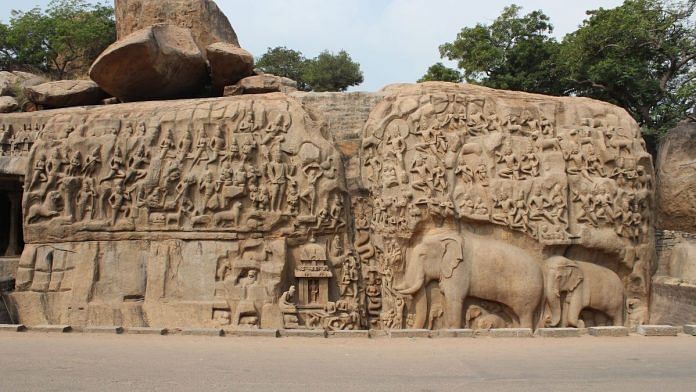A monumental mid-seventh century rock-cut sculptural relief at Mamallapuram in Chengalpattu district, Tamil Nadu, the Descent of the Ganges or Arjuna’s Penance is the largest known bas relief in south India. Carved out of a naturally-occuring boulder, it measures 29.26 metres across and is 13.1 metres tall at its highest. While some scholars have attributed it to the reign of Mahendravarman I, others believe that it was built by his successor Narasimhavarman I, as a symbol of the victory of the Pallavas over the Early Western Chalukyas.
The relief is populated by 150 figures, ranging from gods, goddesses, rishis, hunters and animals to hybrid figures, kiratas and kinnaras. A central cleft or fissure in the rock, presumed to be a natural feature, has been incorporated into the design and subject of the relief: the Ganges river, indicated by the presence of nagas and naginis. An emaciated figure is depicted to the left of the cleft, at the centre of the composition; he stands on one leg in penance. To his left is Shiva attended by ganas, apparently granting him a boon with one hand in the varada mudra. Directly underneath is a depiction of a shrine to Vishnu, before which sits an aged sage along with three disciples while four other ascetics perform various rites of penance and ritual worship. On the opposite bank of the river is a herd of elephants with their young. Immediately beside the feet of the first elephant is a cat performing penance and being worshipped by mice — a possible reference to a tale from the Panchatantra. The figures all display naturalistic poses and individualised facial features.
The central figures of the ascetic and Shiva have been variously interpreted by scholars. They may constitute a depiction of Arjuna’s penance to acquire the pashupatastra (a deadly weapon) from Shiva to use in the Mahabharata war. It has also been interpreted as the penance of the mythical king Bhagiratha, imploring Shiva to bear the force of the descent of the Ganges from the heavens to the earth. It is possible that the depiction was intentionally made ambiguous in keeping with literary genres of the time, such as dvisamdhi-kavya, or poetry crafted to have multiple possible meanings and interpretations. The relief also depicts a number of other episodes and stories in no single narrative order: it may thus be meant more generally as an allegory for spiritual penance and Shiva’s benevolence. Additionally, since the relief was located at Mamallapuram, a port city frequented by foreign traders, the ambiguity of the images may have served to communicate more universal ideas as opposed to specific cultural markers.
The relief has a pool at its base and a storage tank above; scholars believe that these features indicate that it was used during celebratory occasions. Water may have been let out of the tank to cascade down the cleft to recreate a flowing river. An unfinished relief showcasing the same theme is also located near it, leading to speculation that the site served as an outdoor workshop. As of 1984, the relief was been designated a UNESCO World Heritage Site as a part of the Group of Monuments at Mamallapuram, and continues to be a major tourist attraction as of writing.
This excerpt is taken from MAP Academy’s ‘Encyclopedia of Art’ with permission.
The MAP Academy is a non-profit, online platform — consisting of an Encyclopedia, Courses and a Blog — which encourages knowledge building and engagement with the visual arts of the region.






